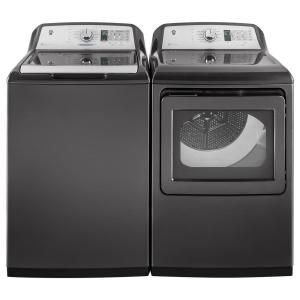What is a washer-dryer?
While the first washing machine was invented in 1767 (the first patent was filed in 1797), the appearance of the first household clothes dryers was much later: it would indeed be necessary to wait until the 1960s. Also known under the name of As a “combined washing machine”, the washer-dryer is a newer model that combines the main functionality of a washing machine and a dryer in one appliance.
Allowing you to wash, spin and dry clothes at the same time, the washer-dryer has been a real revolution in the field of household appliances. It offered households the possibility of reducing the space occupied by their devices by combining their functions, and thus promoting a better arrangement of interiors.
The range offered on the market today is quite extensive. Advances in technology have made it possible to reduce the energy consumption of this all-in-one device and improve its performance.
How does a washer-dryer work?
Washer-dryer lets you wash and dry clothes without having to take out the clothes and place them in a tumble dryer. With a full program, the laundry is first washed in the wash cycle chosen by the user. Then comes the spinning phase.
As with a conventional washing machine, the higher the number of revolutions per minute, the more powerful the spin and the more comfortable the drying. Better spin-drying is also more economical in electricity and water, the latter being necessary to cool the steam generated by condensing washing machines. Finally, the laundry then starts drying automatically.
Two main systems are used to dry laundry: condensation or drainage.
With condensation drying, the steam generated by condensing washing machines is cooled, and the water is collected in a container to be emptied on a regular basis, or it is discharged via a hose. With drainage drying, a flexible duct is connected to a ventilation hole placed in a window or a wall.
In both cases, drying can be done manually or via an electronic system. In the first case, it is up to the user to judge the time needed to dry the laundry. In the second case, the task is entrusted to a probe that measures the humidity level and stops the drying process when the laundry is dry. Please note that if the programme contains both washing and drying, the amount of laundry (usually half the maximum washing load) must be adjusted. The maximum capacities for washing and drying must, therefore, be taken into account when making a product comparison.

Advantages & fields of application
The washer-dryer has several advantages that easily stand out of the best products on the market. First of all, this appliance saves space by offering the main functions of a washing machine and a tumble dryer in a single appliance.
The washer-dryer, equipped with an all-in-one program, also saves time with drying that can be started automatically after the spinning phase of the laundry. With its washing performance as efficient as that of a conventional washing machine, the washer-dryer offers a more complete service and can provide linen ready to iron or ready to put away.
This appliance is indispensable in places where the quantity of laundry is too important to have time to let it dry naturally (for example, sheets in hotels). It is also relevant for users who have little or no room or time to dry laundry at home (e.g. students).
What types of washer-dryers are there?
There are two main types of washer-dryers, depending on the laundry loading method offered.
The “top” washer-dryer
With its loading from the top, the “top” washing machine fills up through an opening on the top. It is particularly suitable for small spaces, takes up little space and allows the tank to be filled or emptied without having to bend down. This type of model is particularly safe and more durable because it has two bearings to hold the drum (against a single bearing for the porthole model).
Porthole or front washer-dryer
Loading a porthole model is done on the front of the machine through an opening on the front. The porthole washer-dryer is larger than a “top” model (60 cm wide against 45 cm for the “top” washer-dryer), but it generally has a higher maximum capacity (between 5 and 12 kg, against 5 and 8 kg for a “top” washer-dryer).
Smaller porthole models are now on the market; the “big size” models do not sufficiently meet customer needs. The porthole models are also more aesthetic than the “top” models with more varied colours and more assertive design.
You will also find on the market two main drying processes.
The washer-dryer by condensation
As explained above, this type of model condenses the water vapour generated by the washing machine. The condensation washer-dryer is very practical for apartment use because it is easy to install.
The washer-dryer by drainage
For this type of appliance, a ventilation hole must be designed that faces outwards into the room where the washer-dryer is installed. As the drainage releases less humidity into the room, a drainage washer-dryer can be installed in a garage or basement. On the other hand, its installation is not relevant in an apartment because of the device required.
What should I look out for when purchasing a washer-dryer?
The number of revolutions per minute when spinning is essential for a washer-dryer. The higher the number, the more efficient this dewatering phase will be and the more comfortable the next drying phase will be (and therefore, the more energy you will save). It is also essential to check the washing capacity, but also the drying capacity.
This will save you from having to empty three-quarters of your machine to go to the dryer. It is also a good idea to check the noise level generated during washing and drying, especially if you do not have an insulated room or laundry room to place your washer-dryer.
We advise finding out what programs are available and how long they last, because this is a frequent source of disappointment when using them. Before any purchase, you should also read the opinions of users, which remain a mine of information to avoid making the wrong choice.
Alternatives to the washer-dryer
If a washer-dryer is too expensive or uneconomical for you, it is possible to combine the use of a washing machine and a dryer – two different appliances that will not necessarily be purchased at the same time. Of course, this alternative involves monitoring the end of the wash and spin cycle to recover the laundry and introduce it into the dryer.
You can also be satisfied with a conventional machine wash followed by a natural drying on a clothesline to speed up the operation. For occasional use, you can go to a launderette equipped with washer-dryers or simply a tumble dryer.
If you wish to buy Washer-Dryers from Turkey, please do not hesitate to contact us by mail at [email protected] or to call us at +90 532 361 5149. We can help you to get in direct contact with producers or provide you with everything that you need.
Please visit the company website for more information about their products. If you want to know about companies in Turkey, visit our website.











